
Mastering the challenges in the healthcare system - with semiconductor solutions for smart health devices
Smart technology for smarter health choices
The future of health and well-being
As the future of health focuses more and more on self-care, customers are spending more on products like smart wearable devices or smart home devices that help to improve their health, fitness, nutrition, appearance, sleep, and mindfulness. And this holds a lot of benefits.
- Smart wearables like fitness trackers enable patients to create their own overview of important health data and allow them to reflect on this with their doctor and derive appropriate, preventive actions.
- The understanding and acceptance of treatments using digital applications has changed fundamentally - decisions are becoming less top-down and more eye-to-eye.
- Health data can be collected and transmitted directly to the doctor via digital applications – for example, in the case of diabetes and high blood pressure. This makes it more efficient and leads to faster results for patients - of course, without losing sight of data security in the process
Enabling new smart health and fitness technologies
Good health increasingly means taking responsibility for our long-term care rather than sporadically treating acute illnesses. It places great emphasis on increasing wellbeing, improving fitness, diet, appearance, sleep and mindfulness to prevent illness. It recognizes the role of the home as an important factor in individual health promotion and - in the event of illness - care. It enables patients to gain an overview of important health data themselves and encourages them to reflect on this with their doctor and derive suitable preventative measures from it. Necessary health data can be transmitted directly to the doctor via digital applications - for example in the case of diabetes and high blood pressure. This makes it more efficient and leads to faster results for patients - without losing sight of data security, of course.
Infineon’s portfolio of innovative and state-of-the-art semiconductor solutions support the design of innovative technologies and devices for smart health monitoring, for example medical wearables, preventive healthcare appliances like sleep monitoring and, in the event of illness: solutions for assisted living at home. Sensors, connectivity technologies and security solutions enable massive improvements in secured, efficient, convenient and patient centered health and well-being solutions as well as services for patient engagement.
Even though medical devices consist of a lot of technical know-how, the focus of smart health devices is always on people and their needs. It is about empowering people to have a better and healthier life.
Easy and intuitive health monitoring everywhere
Health and fitness wearables
The more we focus on our health and fitness, the more we realize how important it is to keep an eye on our health and fitness data at all times. Small wearable devices allow us to do just that - in an easy, intuitive way.
Health and fitness wearables such as smartwatches, sports watches, fitness trackers and healthcare wristbands can be comfortably and discreetly worn on the body and support a growing number of use cases, including health and fitness tracking. Equipped with health monitoring functionalities, wearables can measure physical activity and vital parameters such as heart rate, blood pressure or blood oxygen levels.
In addition to the “classic” wearables for measuring fitness values like smartwatches, sport watches or fitness tracker, more and more new, innovative formats such as rings or other jewellery, are entering the market. Smaller, more inconspicuous, more individual, they pose great challenges to manufacturers in terms of storage capacity, battery life, handling, precision, reliability, security, etc. Users expect a beautiful design with the same or even better functionality and reliable and easy handling.
Oura Ring. Smart ring for fitness, stress, sleep & health monitoring.
The Oura Ring is an innovative wearable that helps you monitor and improve health. Sleep, readiness, and activity - these scores tell you how your body feels and what your body needs, every second of every day. You'll know when you need more sleep, when you might be getting sick, when it's time to push yourself - and more - with a personalized experience on the Oura App.
The Oura Ring requires long-lasting battery life, increased processing capacity, and the use of advanced sensors, all in a stylish and comfortable form factor. This innovation is delivered through PSoC™ 6 MCUs, enabling features like a small form factor, data storage, Bluetooth low energy, extended battery life, sensor fusion, and data processing.
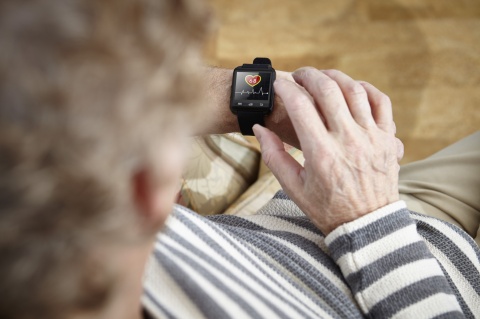
Wrist-worn health bands are becoming more and more popular among elderly people. Medical bands offer a range of health-monitoring features that keep users updated about their health status in real-time. In addition to general health and activity tracking, they can also help users to manage underlying diseases or chronic conditions by connecting with telehealth services and transmitting specific health metrics such as heart rate, blood pressure, and blood sugar levels to a healthcare provider of their choice. Location and fall detection can add another safety net. All of which can enable elderly people to live safely and independently – for longer.
Everything it takes for safe, secure and reliable healthcare bands
Click here to learn more about our extensive portfolio covers all sensing, computing, memory, power and connectivity building blocks needed to create safe, reliable wrist-worn healthcare devices.
Health monitoring @ home
Solutions for the smart home
The increase in chronic diseases and health problems in our society often entails the need for home care or self-treatment at home. The desire for a self-determined life is just as decisive for this as the lack of suitable facilities in some regions. This is where the smart home can help with home automation and health monitoring solutions.
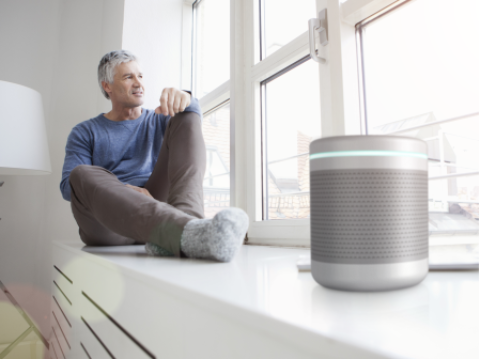
Smart home technologies can provide some simple services while collecting health data that can help people in need of care to reduce their dependence on healthcare providers and improve their quality of life at home. Health monitoring at home also helps to keep an eye on the state of health and, if necessary, to take countermeasures if health values deviate.
Discover innovative solutions supporting health and well-being at home:
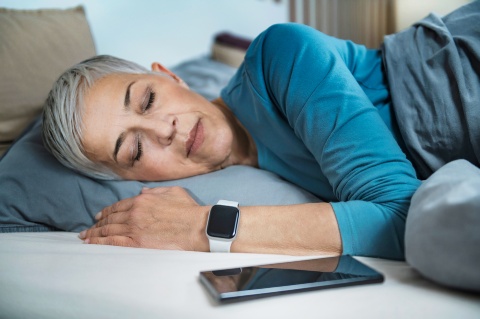
There is no doubt about how important good sleep is for physical and mental well-being. The quality of sleep affects how fit and efficient one is during the day. Sleep even affects the risk of developing lifestyle diseases such as obesity, depression and type2 diabetes. Unfortunately, many people struggle with intermittent or even regular sleep problems. Finding out the reason for this often proves difficult. Sleep monitoring can help here to measure the quality of sleep and gain valuable insights into individual sleep patterns.
Infineon’s next generation radar based XENSIV™ Sleep Quality Service is a fully integrated hardware and software solution for OEMs to help improve people’s sleep.
Radar solutions are a key enabler for the digitalization of medical healthcare in sleep improvement solutions like the solutions of Sleepiz or Tsingray.
The biggest highlight of the Tsingray device is the adoption of millimeter-wave radar tomography sensing technology pioneered in the industry. With 2.5cm resolution chromatography and 100ms refresh period, it can monitor from multiple dimensions such as sleep, breathing, heart rate, body movement, sleeping posture, etc., that is, all the micro-motion data of the monitored person during sleep can be completely recorded.
How do Infineon’s products contribute to this innovative Tsingray solution?
The smart sleep breathing monitoring device, using Infineon’s XENSIV™ mm-wave 60GHz radar chip, has recently been included in the cooperation of Tsingray with JD Health. This device is now part of a healthcare online service package for sleep quality improvement of "JD.com”, a huge online trading platform based in Greater China. In addition to Infineon’s XENSIV™ millimeter-wave radar chip, Tsingray is also adopting Infineon's Wi-Fi/BLE, PSoC MCU and OPTIGA™ Trust B security chip solutions for the development of next-generation products of this sleep monitor.
With the support of Infineon’s XENSIV 60GHz mm-wave radar chip, the smart sleep breathing monitoring device is capable of realizing:
- Non-contact and non-sensitive continuous sleep monitoring and collection of real-time data all night long without affecting sleep.
- Accurate perception of vital signs and body movement micro-data of the whole sleep process, and multi-dimensional sleep monitoring by mm-wave chromatography.
- Automatic generation of monitoring reports providing data reference for customized sleep improvement plans, expert consultation, follow-up visits
- Diagnosis of sleep problems by AI auxiliary diagnosis and treatment system.
- Measurement of distance between objects with mm level precision with lower power consumption and minimal volume.
- Non-contact monitoring method, which avoids users’ discomfort, making the device very suitable for long-term home monitoring.
- Timely warning of sudden sleep death omens, long-term apnea and other dangers, which fills the gap of accurate monitoring of nighttime breathing patterns and heartbeat patterns.
- Support of the diagnosis of chronic breathing diseases such as chronic obstructive pulmonary disease, asthma, apnea and hypoventilation.
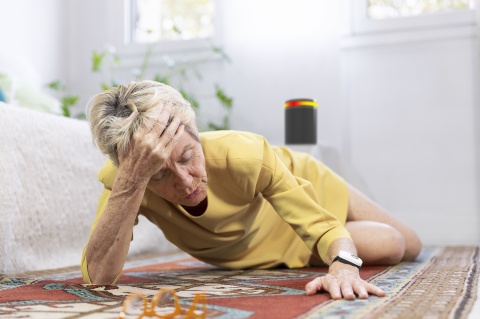
With smart speakers becoming the central control hubs of smart houses, presence detection enabled by a radar sensor allows OEMs to provide advanced, innovative features to differentiate their products in this highly competitive and rapidly growing market segment. Adding a radar sensor can improve the user experience by sensing the “real” presence and location of a person. Because it can detect the direction of movement (angle of arrival), the smart speaker for example is now aware that someone is approaching so that it can power up the VUI and internet connection to be ready to listen for commands. There is now no longer a need for a ‘wake up’ word.
Health monitoring features for smart speakers enabled by radar sensors
The amazing sensitivity of a radar sensor enables smart speakers to have new features for health monitoring. This is an exciting new area that address the growing awareness of the importance of health monitoring as can be seen by fitness trackers and the features built into smart watches such as exercise, sleep and heart monitoring. Thanks to a radar sensor’s sensitivity, which can even detect a pulse in a wrist, there are now many health monitoring opportunities that can be designed into a smart speaker with a radar sensor to add user value with hardly any impact on the system costs as these are all in software.
Examples are the use cases of fall detection, unobtrusive monitoring of elderly people who unexpectedly change their daily routines so that they can be checked in case of a problem, monitoring of respiration rate, irregularities in heart rate patterns as an early warning of a possible problem, and even coughing or snoring. All of which can be done automatically eliminating the problem when the elderly person forgets to wear the monitoring device.

With the recent pandemic, awareness of indoor air quality is rising. At the same time, energy-efficiency is an important topic of our time. Efficient building insulation can help save energy - but heavily insulated homes are not always good for health. Poor ventilation can lead to lower oxygen levels and a buildup of carbon dioxide (CO2). Even moderate CO2 levels can have a negative impact on health and productivity - people become drowsy and have difficulty concentrating. So the demand is growing for smart indoor air quality sensors that can "smell" rising CO2 levels and either warn the user or trigger a system response. Real-time CO2 monitoring for demand-controlled ventilation systems, air purifiers and thermostats allows users to accurately measure and adjust indoor air quality.
eesy-innovation launches an easy-to-use consumer CO2 sensor to improve health and mental well-being
In the light of the COVID-19 pandemic and overall increased health concerns, co2go® is the answer to a growing need and demand for CO2 sensors in the end user market space. The innovative mobile CO2 sensor, developed by our Associated Partner eesy innovation, is able to measure the levels of CO2 indoors wherever you are. The co2go® may be easily linked to a smartphone or laptop, and it offers transparency through information about the quality of the air in your immediate surroundings - enabling you to optimize your health and mental well-being. The CO2 level is indicated through a traffic light display on the device itself. Additionally, a dedicated Desktop App is available via the connected laptop.
The co2go® device is easy-to-use and enables consumers to protect themselves from an invisible hazard in the air – heightened CO2 levels. This sensor can be used wherever there are people gathering in a closed space, such as classrooms, offices, meeting rooms, restaurants, or simply at home.
Unlike previous CO2 devices that use an indirect measurement method like electrochemical methods (EC), infrared light (NDIR) or equivalent carbon dioxide (eCO2), co2go® uses the superior technology of Infineon´s new XENSIV™ PAS CO2 sensor and can quantify CO2 levels directly through photoacoustic spectroscopy (PAS).
In comparison to products available before and thanks to Infineon’s innovative sensor technology, the co2go® features an outstanding measurement accuracy with a very small footprint. Previous size, performance and cost restrictions could be eliminated. This technological breakthrough paved the way to the mobile small form factor for an everyday, personal, and portable health assistant device.
Protecting sensitive health data
Healthcare privacy and security
In recent decades, the use of digital technologies in health and lifestyle has advanced exponentially. The potential applications are many: imaging for diagnosis, electronic health cards, robotics in surgical procedures, telemedicine, home and mobile monitoring devices to monitor the health of individuals. This increase in digitalization makes the safeguarding of health and patient data urgent and is a basic requirement for the functioning of the digital health system.

Equipping smart health appliances with the right security solutions from the get-go is key to helping prevent attacks – whether theft, fraud or manipulation. Companies who are looking for a security solution need one that is equally easy to use – in terms of fast integration and time to market – and trustworthy. Unlike software-only solutions a hardware-based solution is strong, tamperproof and provides a solid foundation. Infineon's independently-certified hardware security solutions are pre-integrated and therefore easy to integrate into your system. The OPTIGA™ Trust and OPTIGA™ Authenticate S solutions protect the storage and transfer of highly sensitive personal healthcare data.
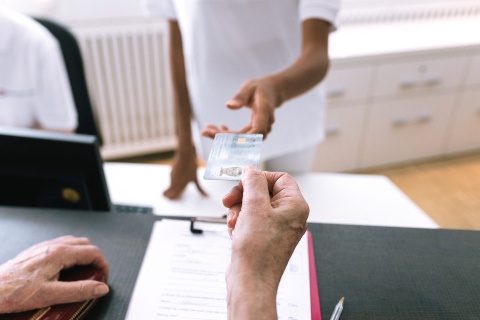
Worldwide, healthcare fraud costs insurance authorities and companies hundreds of millions of dollars every year. With conventional systems based on paper or memory cards, it is difficult for authorities to ascertain whether the patient or user is actually the insured.
Enhancing fraud prevention with electronic health cards
While electronic health cards promise greater convenience and an improved patient experience, e-health cards must ensure that personal medical records do not fall into the wrong hands.
Electronic health cards are becoming an increasingly effective way of preventing fraud – particularly as they evolve towards more sophisticated identification mechanisms such as biometrics. E-health cards have the potential to improve the patient experience by storing key medical data and medication history, and by serving as an electronic prescription. These cards can also be used to securely store social security numbers.
Given the sensitive nature of medical data stored on e-health cards, they must offer robust protection of privacy. Widespread adoption also calls for ease of administration and – most importantly – a mature telematics infrastructure to network all players in the care continuum and enable dynamic updates of data and functionality.
Leading technologies for tomorrow’s eHealth cards
Customers value in particular the ability of our controllers to protect sensitive data, while delivering the memory, performance and cost efficiency required for future-proof electronic health cards. The SLE 78 features Integrity Guard, for instance, a self-checking dual CPU which not only stores, but also internally processes sensitive data in encrypted form.
Designed specifically to ease security implementations and certification processes, Integrity Guard combined with our SOLID FLASH™ memory radically reduces cost of ownership by accelerating time to market.
For ease of deployment, we also deliver fully integrated software solutions on native or on Java platforms.

Definition and facts
What are smart health appliances?
Just a few years ago, digitalization in healthcare may sounded distant, but it is already in full swing now. Smart health appliances such as fitness tracker and smart watches can record and document data in real time. Important medical appointments can be set up digitally to help efficiently from any location. Decision-making and self-care behaviors are digitally supported and encouraged like never before. All of this enables patient engagement to support healthiness and well-being what will become increasingly important in the future.
Why it that?
We live in a world of rising population. The latest projections by the United Nations suggest, that the global population could grow to around 8.5 billion in 2030 and 9.7 billion in 2050. At the same time, life expectancy is increasing and will reach a global average of 77.2 years in 2050 (1)
This development presents us with challenges: Everybody wants to live healthy, vital, and as independently as possible into old age. According to the United Nations Sustainable Development Goal No. 3, for sustainable development it is imperative to ensure health and well-being across all ages(2). In order to achieve this and prevent a collapse of the healthcare system, the topics of preventive healthcare, self-care and well-being are becoming more important. A key factor in achieving this is digitalization and the Internet of Medical Things (IoMT), also called healthcare IoT.
Sources
[1] United Nations (2024). World Population Prospects 2024: Summary of Results. UN DESA/POP/2024/TR/NO. 9. New York: United Nations.
2) United Nations: Sustainable Development Goals; https://unric.org/en/sdg-3/
